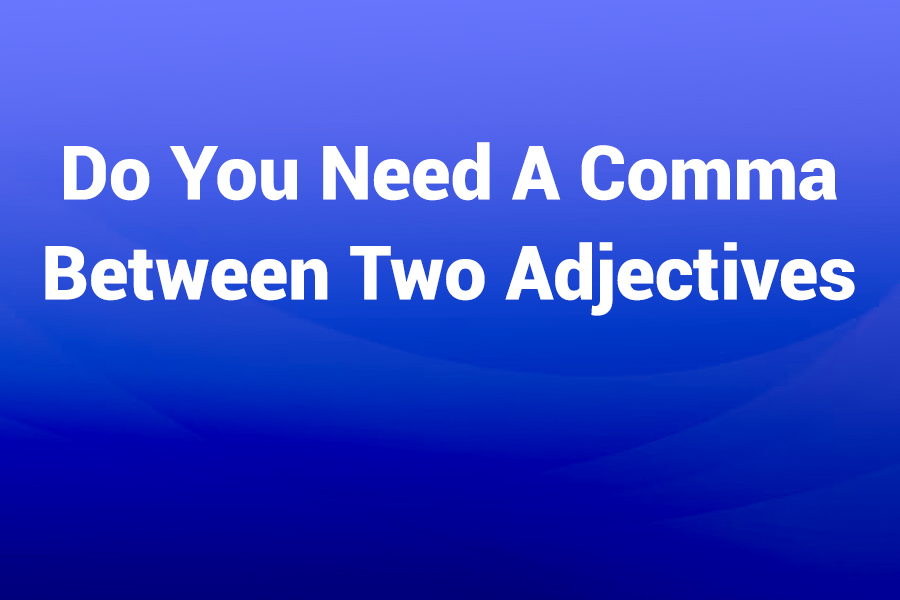The question “do you need a comma between two adjectives” trips up many writers—even seasoned ones. When two words describe the same noun, should they be separated by a comma or run together?
The answer depends on how those adjectives relate to the noun and to each other. In this article, you’ll learn exactly when to use a comma between two adjectives and when not to, with easy-to-follow rules, tests, and real-world examples.
In this article we’ll cover the coordinate vs. cumulative adjective distinction, the “and” and reversal tests, common pitfalls, plus style tips for U.S. writing.
Why This Matters
Misplacing commas—or omitting them incorrectly—can confuse readers or make your writing look amateurish. Grammar style guides and usage experts agree: proper comma use between adjectives enhances clarity and flow.
Recent surveys of writing usage show that punctuation errors cluster around modifiers, making this rule especially useful.
What Are Coordinate vs. Cumulative Adjectives?
Before you decide on a comma, you must identify coordinate and cumulative adjectives.
- Coordinate adjectives each separately modify the noun. They have equal weight.
- Cumulative adjectives build on each other; the modifiers stack in a specific order.
If adjectives are coordinated, you should use a comma (or the word “and”) between them. If they are cumulative, you should not.
How to Test Whether to Use a Comma
Two simple tests help you decide:
- The “and” test
Insert “and” between the two adjectives. If the sentence still sounds natural (without altering meaning), the adjectives are likely coordinate—and a comma belongs.
Example:- “He is a strong, healthy man.” → “strong and healthy man” works.
- “an expensive summer resort.” → “expensive and summer resort” sounds wrong — no comma.
- The reversal test
Reverse the order of the adjectives. If the phrase still makes sense, they are coordinate.
Example:- “a long, narrow path” → “a narrow, long path” also works.
- “the big red house” → “the red big house” feels awkward.
If both tests succeed, use a comma. Many usage experts, including The Chicago Manual of Style, call these “coordinate adjectives.”
If one or both tests fail, the adjectives are cumulative, and no comma goes between them.
Coordinate Adjective Examples
- The sleek, modern design impressed the judges.
- She wore a bright, colorful scarf.
- He drove a fast, efficient car.
In each case, you can say “sleek and modern design,” “bright and colorful scarf,” or reverse the adjectives without changing meaning.
Cumulative Adjective Examples
- The little red wagon (you wouldn’t say “red little wagon”)
- A three-story building (you wouldn’t say “story three building”)
- Her tenacious brand loyalty (you couldn’t sensibly say “brand tenacious loyalty”)
Here, the adjectives rely on a fixed order or a hierarchical relation; they aren’t separate modifiers.
Why Commas Matter in Meaning
Sometimes a comma changes meaning. Consider:
- “a light green suit” (a suit that is light and green?)
- “a light, green suit” (a green suit that is lightweight?)
The comma shifts emphasis to both descriptors equally. Grammar authorities warn that commas can alter interpretation. Use them intentionally, not by habit.
When Multiple (More Than Two) Adjectives Appear
The same rules apply when you have three or more adjectives. You comma-separate coordinate adjectives but not cumulative ones. Example:
- “a lovely, long, refreshing drink” — all three are coordinated, so commas join them.
- “a delicious chocolate cake recipe” — “delicious chocolate cake” contains cumulative adjectives; no comma between “delicious” and “chocolate.”
Use your tests between each pair of adjectives in sequence.
Common Traps and Misconceptions
- Some writers assume all adjectives before a noun need commas. That’s wrong. Many are cumulative and shouldn’t take commas.
- Others misapply the tests. The “and” test must preserve natural meaning; forcing “and” where it feels awkward may mislead you.
- Don’t confuse adjective-noun compounds, e.g. “hot dog stand” or “ice cream shop.” These are units and don’t take commas between the modifier and noun.
- Creative or poetic writing sometimes bends the rules—yet clarity should remain your priority.
Style Guidelines and American Usage
In U.S. English, many style guides (like Chicago) recommend using commas between coordinate adjectives. The Chicago Manual of Style (17th edition) endorses the “and” and reversal tests. Other guides emphasize the importance of not overusing commas to maintain smooth readability.
In recent editorial surveys, adjective-punctuation errors remain common. Writers often either undershoot (leaving out needed commas) or overshoot (inserting unnecessary ones). A disciplined mindset—using the tests above—guards against both errors.
Step-by-Step Strategy for Writers
- Identify adjacent adjectives before a noun.
- Try adding “and” between them.
- Try swapping their order.
- If both versions work naturally and preserve meaning, place a comma.
- Otherwise, don’t.
Keep your writing fresh and uncluttered. Only insert a comma when it genuinely clarifies or smooths reading.
Bonus Tip: Adjective Layers and Categories
Some adjectives refer to opinion (beautiful, dreadful), some to size (big, small), some to color, origin, material, purpose, etc. Typically, opinion adjectives may coordinate with commas, while more descriptive qualifiers (size, color, origin) stack cumulatively. For example:
- “a beautiful, ancient artifact” (both opinion) → comma.
- “a beautiful red dress” → no comma, because “beautiful” (opinion) modifies “red dress” (color + noun).
Use your tests in borderline cases.
Final Thoughts
So do you need a comma between two adjectives? Only when they act as coordinate adjectives—separately modifying the same noun. Use the “and” and reversal tests to determine that. Otherwise, leave adjectives cumulative and comma-free.
This disciplined approach avoids clutter and ambiguity. Mastering this rule gives your writing precision, and readers will appreciate the clean clarity.
